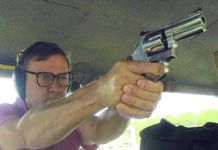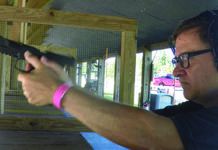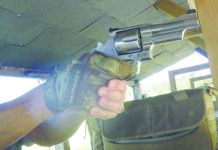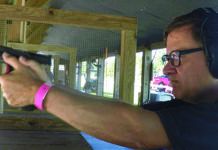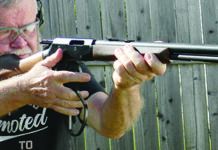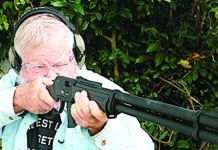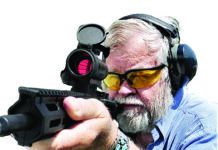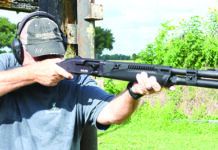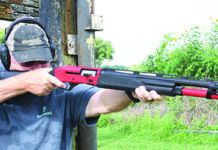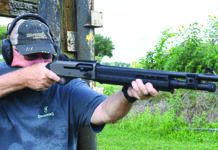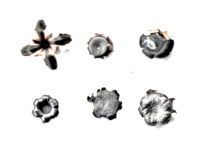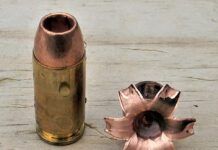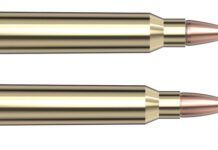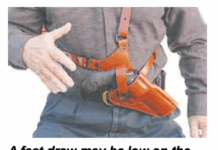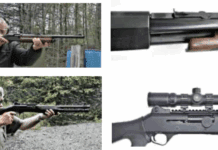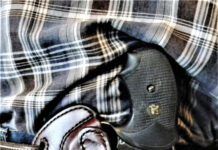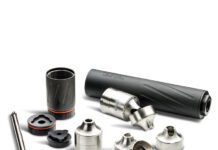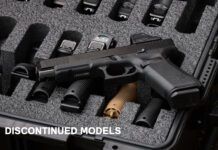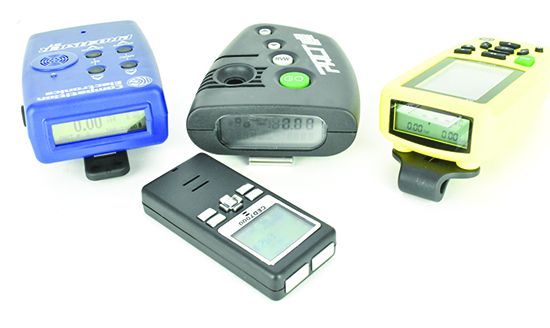Earlier this year, Gun Tests reader Matt W. requested a comparison of popular timers. We thought he had great insight about the value of these pieces of equipment because, outside of gear used in the Olympics, the electronic timer may be the most important piece of match-management equipment in modern shooting sports. More broadly, timers are also important for the shooter who wants to practice and improve his or her gun-handling skills, such as drawing from concealment and reloads. In fact, many of the evaluations we do in Gun Tests require timers to compare the performance of Gun A versus Gun B, so we have a keen interest in them as well.
We suppose this dates us, but some members of the Houston test crew remember when USPSA (United States Practical Shooting Association) matches were run by Range Officers using whistles and stop watches. Shortly after that, we witnessed all the dinosaurs dying off, along with the invention of the electronic shot timers.
The earliest shot timers were large, clunky, prone to breakage, not very sensitive, and expensive. We are talking several hundred 1985 dollars. That said, they were a marvelous upgrade from the whistles and stop watches we started with. One of our testers remembers shooting to a tie with another competitor and losing by .03 seconds on the stopwatch. Totally within the margin of error and well worth the effort to campaign for a tie, he still came in second place. Modern sound-based timers eliminate most of that potential for error.
With our history, we wanted to take a look at the features of the latest crop of timers and selected what we believe to be the four most popular types.
● Our first choice was the PACT Club Timer III, $130. The largest timer in this group, it is simple to operate, and the screen is easy to read.
● Next is the Pro Timer BT (Bluetooth) from Competition Electronics, $160. More compact than the PACT, the view screen is correspondingly smaller.
● Our third choice was the CED 7000, $130. Easily the most compact unit in our test, the whole thing fits in a shirt pocket, while the view screen is relatively large.
● Our last selection hailed from Kestrel, the weather-meter folks. The Kestrel KST1000, $300, is on the larger end of the spectrum as well as being the most expensive. That said, it also brings more features to the table, including two viewing screens and an easy interface for programming.
How We Tested
We assumed that the time-measuring portion of the equipment was accurate and consistent. That left us needing to know what functions the units could perform, along with what the limitations were. We wanted to know how easily the timers could be programmed.
We have occasionally seen issues with timers not activating with softer muzzle reports. As a result, we tested for proper activation on shots fired from a standard centerfire rifle (Tikka 308 Winchester with a 20-inch barrel), a long-barreled centerfire rifle with a muzzle brake (Christensen Arms MPR 7 PRC), a suppressed rifle (a CVA chambered in 300 Blackout) shooting both supersonic and subsonic loads, a 22 LR rifle (Ruger American), a 9mm pistol (Springfield Armory Prodigy) and a 22 LR pistol (S&W M&P22). We shot multiple rounds though each firearm/ammo combination with the timers set about 2 feet from the muzzles and then again at 9 feet.
The concept of a shot timer is simple. A microphone picks up the sound of a shot and records the time at each instance — usually to the hundredth of a second. Most timers will allow you to review the entire string of shots and compute the splits (time between shot) for each round fired. Most timers (all of ours do) will allow the user to set a “Par” time that is simply a fixed stop or end time. The timers will normally show shots after the stop beep. Our samples will allow for a delayed start beep, which is very important if the shooter is timing himself. He can press the button, get set, and then start. Options at this point can include a fixed delay, random delay, or both. Some of the more advanced models allow the users to set the sound level of the start beep. Each of our four test timers had its own list of additional features, and we are going to examine those for you. We also offer our opinions on how usable each of the timers was when used by a single shooter.
Here’s how the timers performed for our shooters:
CED 7000, $130
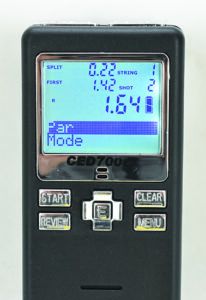
Professional instructors (just like hunters or competitive shooters) tend to be hard on their gear, and we are no exception to that rule. We’ve used both CED 7000 and CED 8000 timers through the years, and they have served us well. The CED 7000 is the smaller of the two and the smallest unit we tested in this group. Less than 2 inches wide, 4 inches long and not even an inch thick, it fits easily in the shirt or pants pocket and still provides big unit service.
The CED 7000 also does several things differently from the other three timers in our test. It is the only unit that does not have a read out on the top; rather, it’s on the face of the timer only. That leaves room for additional Review and Start buttons on the top, where they are easy to see and access. It also means that the shooter is not going to be able to see the readouts while the CED is hanging on the belt. A belt clip is available for purchase, but it assumes that the shooter will also want the protective skin (available for additional cost) and doesn’t fit unless the skin is used. Then, the CED must be tilted up to view. None of this is an issue unless the shooter is by himself and actually wants to put two hands on the firearm. Imagine that.
For a small timer, the CED’s screen is large, the readout easy to see, and the menu is easy to use. The CED uses seven buttons that are large enough to manipulate and that make navigating the menu easy. The screen shows number of shots, last shot, split times, and total time. If the shooter uses a delayed start or a par time, that is shown as well. The CED 7000 even provides options like a stopwatch and a spy time in case the shooter wonders just how well their chief competition is doing.
The CED 7000 is the only rechargeable unit in the group. It also has a jack for an external speaker, something we’ve seen used in group classes. Unlike the Competition Electronics unit, the CED 7000 has a sensitivity setting that worked perfectly for us from the beginning.
The CED 7000 is one of the handiest little timers we’ve ever used. It is very light and convenient when working with a student or another shooter at the match. We find the tilting clip arrangement required for a single user to view the output to be less than optimal, but certainly not a deal breaker.
Our Team Said: The unit is a great price at $130 but, if you want to use it solo, do yourself a favor — buy the belt clip and a skin, which will add about $30 more to the total price. Both accessories are available on the company’s website, The CED 7000 registered every shot at every distance, first try. Very small, it is still easy to read and easy to program with a proportionately large screen. The CED 7000 is our Best Buy recommendation with a lot of power in a small package at a great price.
Gun Tests Grade: A-
Best Buy
Competition Electronics
Pro Timer BT, $160

The Competition Electronics Pro Timer BT (Bluetooth) costs more than the PACT timer but brings more selections to the menu. Of course, it includes options for Review, Par Time, and Start Delay Type (Instant or Delay). It can store multiple strings of fire for review. The Pro Timer also includes a backlit screen (if desired), adjustable beeper volume and sensitivity, along with the potential to compute hit factors for scoring. There is even an LED that can flash with the start button, giving a little help to those of us with hearing challenges.
The Bluetooth option obviated some of the concerns we had with the unit. The screen is smallish and contains all the info the shooter or the range officer needs, with the time being the only data presented in a large font size. But that is the important part. The menu is fairly extensive, but a bit difficult to navigate, with the smaller screen and the Pro Timer’s limit of four buttons. With the Bluetooth enabled and linked to an iPhone, many of the options could be viewed and selected in a much larger interface.
The rest of the physical features were similar to those of the PACT timer. The overall size is reasonable and easy to hold in a single hand. There is an integral belt clip that, when attached, leaves the display where the shooter can easily see the readout. Power comes from a single 9-volt battery that is predicted to last for about 25 hours of use. Competition Electronics also includes a blue skin that helps with drop protection.
We got a dose of our own medicine when we tested this timer. We’ve used these before, so we had confidence that we could scan the instructions and everything would be fine. We wuz wrong. When we hit the range and did our initial testing, the only firearms the Competition Electronics timer would register were loud rifles sitting close to the unit. It wouldn’t pick up either handgun or the 22 LR rifle at all. Not accepting that this was the best a good timer could do, we swallowed our pride and read the manual carefully a second time. We quickly discovered that there was a sensitivity setting that was at 50% coming from the factory. Bumping that up to 80% solved all our problems. Mea culpa.
Our Team Said: We had initial problems with factory setting on the microphone sensitivity with the Competition Electronics timer. Once we read the manual and adjusted that setting, the problems went away, and we were pleased with our results. The Competition Electronics Pro Timer costs a little more but adds quite a few features to the mix, including the ability to Bluetooth to your phone.
Gun Tests Grade: B
Kestrel KST1000, $300
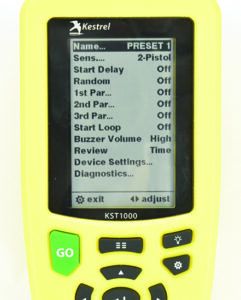
Shooting a long-range rifle and actually connecting with the target requires a good bit more than a decent rifle and appropriate ammunition. The atmosphere can quickly change viscosity, requiring the shooter to use different solutions. Scopes may need to be dialed higher or lower. Wind (the reason most people miss at distance) can change by the second and must be accounted for. Enter Nielsen-Kellerman and their Kestrel line of environmental meters. We’ve been using their 5500 and 5700 for years to tell us what data we should input into our ballistics solvers. Their products take much of the guesswork out of distance shooting, allowing the shooter to work on their part. Recently, Kestrel introduced a new product into the competition circuit in the guise of a new timer. It is a medium-sized unit that is the most expensive in this test, and it allows you to control just about everything. The Kestrel KST1000 may cost more, but it gives you more for it.
The main screen is the largest in this test. Results shown include total time in a large and easy-to-read font, number of shots, first-shot time, and split time for the last two shots. Yes, we said main screen. There is a secondary screen located on top that shows the same info, so the shooter never has to pull the timer off the belt or tilt the timer up.
The face of the KST1000 closely mimics that of the company’s environmental meters. The gear-looking button brings up all of the potential settings. The KST1000 provides instant or delayed start buzzers, and the shooter can set his own parameters on the delays. There is a microphone-sensitivity option that provides settings for rifle, pistol, 22 LR unsuppressed, suppressed 22 LR, and the pièce de résistance — a sensitivity level that records hammer fall from a pistol being dry fired. Now the shooter can actually get a real time when he is practicing at home alone. Other available options include multiple par times, buzzer volume, and the ability to record multiple strings.
Everything is packaged in a yellow case that can be seen in the grass from 14 miles away, or close to that. There is a connector for a wrist strap and a battery compartment that holds two CR123 batteries. There is also a monster belt clip that we don’t see breaking any time soon.
We found the Kestrel easy to see and easy to program. Our shooting tests showed that the factory setting wouldn’t pick up the suppressed 300 Blackout at 2 feet, though it registered the shots from the same ammo at 9 feet. Changing the mike sensitivity to the appropriate level alleviated the problem. The Kestrel may come at a Cadillac price, but we found it to be a Cadillac quality timer.
Our Team Said: The most expensive unit in the test, the Kestrel KST1000 is loaded with extra features. We loved the adjustable level for the start beep and a microphone sensitive enough to pick up the fall of a hammer when dry firing.
The Kestrel KST1000 was Our Pick for its features and ease of use. It also costs $300. The price cost this timer part of a grade, so if you’re not affected by what the Kestrel costs, then subtract the minus sign and give this an A grade. Grab it if you can afford it.
Gun Tests Grade: A-
Our PICK
PACT Club Timer III, $130
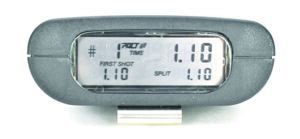
The PACT Club Timer III was our first choice and a logical one. Several members of this test group have participated in a USPSA club that has used a PACT timer for decades — totally possible since the original PACT was introduced in 1982. The current Club Timer III hit the streets in 2012 and has served us well.
Our PACT timer is wide with a screen to match. PACT had the wisdom to use a large font size, making the readout very easy to see. A typical screen showed us the number of shots fired in the string, time to first shot, total time, and the split time between the last two shots. The Go/Start button is easy to find. Press the button and the time begins on release. A Review button sits just below the Go button and allows you to review all shots in the string. Easy peasy. There is an integral belt clip, making it simple for the competition Range Officer or the individual shooter to store the unit on their belt. Power is supplied by a 9-volt battery. The unit will turn itself off after several minutes of inactivity.
Additional programming is a bit more ponderous. With only two more buttons, down arrow and up arrow, the buttons must be pressed simultaneously or in specific order to bring up certain menus and activate commands. Even within the simple menu system, delayed or instant start commands are available along with Par time. According to the PACT manual, the microphone’s sensitivity can be adjusted, though the company recommends the user leave it alone. Accordingly, all the shooting results we had were observed using the original factory setting.
We found the primary controls to be very intuitive and easy to use. We found some gaps in what the microphone would detect, but they were situations that didn’t surprise us or concern us. The first was failure to detect a Christensen Arms MPR with a very loud muzzle brake. The PACT recorded the shots from 2 feet but wouldn’t pick up the ones at 9 feet. The separation may well have placed most of the noise generated behind the timer due to the action of the brake. It also had trouble with the subsonic 300 Blackout loads as well as those from the 22 LR rifle, both at 2 feet and 9 feet.
Our Team Said: Well proven over the years, the PACT Timer has provided great service to a USPSA club we frequent. Simple to use and sturdy, options are limited. Microphone sensitivity was good, though not great.
Gun Test Grade: B
| SHOT-TIMER SPECIFICATIONS | ||||
|---|---|---|---|---|
| Model | PACT Club Timer III | Competition Electronics Pro Timer BT | CED 7000 | Kestrel KST1000 |
| Price | $130 | $160 | $130 | $300 |
| Weight | 7.0 oz. | 7.3 oz. | 2.7 oz. | 9.0 oz. |
| Dimensions | ||||
| Maximum Width | 3.85 in. | 3.24 in. | 1.86 in. | 2.75 in. |
| Maximum Length | 4.73 in. | 5.0 in. | 3.98 in. | 5.13 in. |
| Maximum Thickness | 1.43 in. | 1.54 in. | 0.83 in. | 1.55 in. |
| Belt Clip | Integral | Integral | Available | Integral |
| Protective Skin | Available | Available | Available | NA |
| Start Beeps | ||||
| Adjustable Volume | N | Y | Y | Y |
| Instant | Y | Y | Y | Y |
| Fixed Delay | N | Y | Y | Y |
| Random Delay | Y | Y | Y | Y |
| Split Times | Y | Y | Y | Y |
| Multiple Strings | N | Y | N | Y |
| Backlight | Y | Y | Y | Y |
| View Screens/Location | 1, top | 1, top | 1, top | 2, front and top |
| Made In | U.S. | U.S. | Mexico | U.S. |
| Warranty | 1-year repair | 2-year limited | 2-year limited | 5-year limited |
| Telephone | (815) 874-8001 | (610) 366-9752 | (888) 628-3233 | (800) 781-4221 |
| Website | PACT.com | Competition Electronics.com | CEDHK.com | Kestrel Ballistics.com |
| SHOT-TIMER SENSITIVITY TRIALS | ||||
|---|---|---|---|---|
| Model | PACT Club Timer III | Competition Electronics Pro Timer BT | CED 7000 | Kestrel KST1000 |
| Adjustable Sensitivity | Y** | Y | Y | Y |
| Christensen Arms 7 PRC | ||||
| 2 Feet | Y | Y | Y | Y |
| 9 Feet | N | Y | Y | Y |
| Tikka 308 Winchester | ||||
| 2 Feet | Y | Y | Y | Y |
| 9 Feet | Y | Y | Y | Y |
| CVA 300 Blackout Supersonic | ||||
| 2 Feet | Y | Y* | Y | Y |
| 9 Feet | Y | Y* | Y | Y |
| CVA 300 Blackout Subsonic | ||||
| 2 Feet | N | Y* | Y | Y* |
| 9 Feet | N | Y* | Y | Y |
| Ruger American 22 LR | ||||
| 2 Feet | N | Y* | Y | Y |
| 9 Feet | N | Y* | Y | Y |
| Springfield Prodigy 9mm | ||||
| 2 Feet | Y | Y* | Y | Y |
| 9 Feet | Y | Y* | Y | Y |
| Smith & Wesson M&P 22 | ||||
| 2 Feet | Y | Y* | Y | Y |
| 9 Feet | Y | Y* | Y | Y |
* Registered shot with increased sensitivity setting. ** Manufacturer does not recommend changing sensitivity.
Written and photographed by Joe Woolley, using evaluations from Gun Tests Team members. GT



